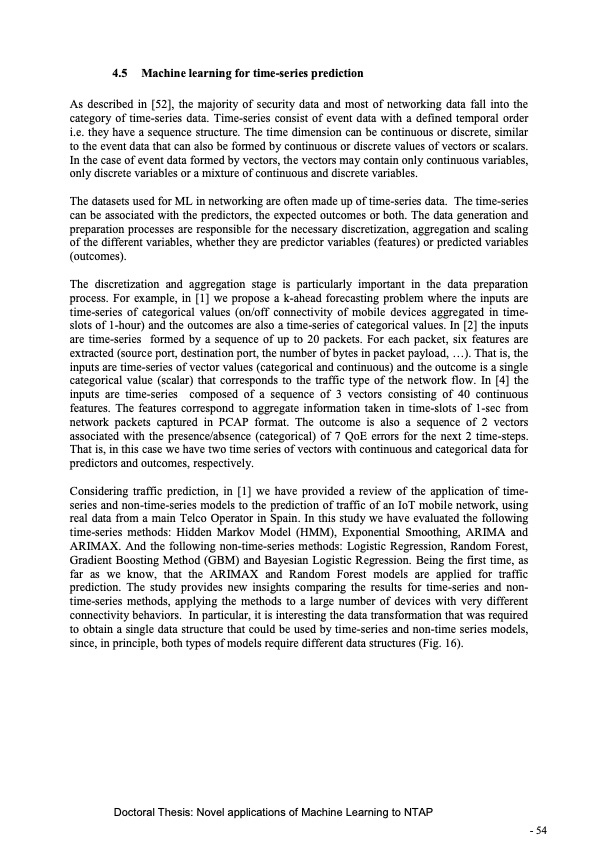
PDF Publication Title:
Text from PDF Page: 056
4.5 Machine learning for time-series prediction As described in [52], the majority of security data and most of networking data fall into the category of time-series data. Time-series consist of event data with a defined temporal order i.e. they have a sequence structure. The time dimension can be continuous or discrete, similar to the event data that can also be formed by continuous or discrete values of vectors or scalars. In the case of event data formed by vectors, the vectors may contain only continuous variables, only discrete variables or a mixture of continuous and discrete variables. The datasets used for ML in networking are often made up of time-series data. The time-series can be associated with the predictors, the expected outcomes or both. The data generation and preparation processes are responsible for the necessary discretization, aggregation and scaling of the different variables, whether they are predictor variables (features) or predicted variables (outcomes). The discretization and aggregation stage is particularly important in the data preparation process. For example, in [1] we propose a k-ahead forecasting problem where the inputs are time-series of categorical values (on/off connectivity of mobile devices aggregated in time- slots of 1-hour) and the outcomes are also a time-series of categorical values. In [2] the inputs are time-series formed by a sequence of up to 20 packets. For each packet, six features are extracted (source port, destination port, the number of bytes in packet payload, ...). That is, the inputs are time-series of vector values (categorical and continuous) and the outcome is a single categorical value (scalar) that corresponds to the traffic type of the network flow. In [4] the inputs are time-series composed of a sequence of 3 vectors consisting of 40 continuous features. The features correspond to aggregate information taken in time-slots of 1-sec from network packets captured in PCAP format. The outcome is also a sequence of 2 vectors associated with the presence/absence (categorical) of 7 QoE errors for the next 2 time-steps. That is, in this case we have two time series of vectors with continuous and categorical data for predictors and outcomes, respectively. Considering traffic prediction, in [1] we have provided a review of the application of time- series and non-time-series models to the prediction of traffic of an IoT mobile network, using real data from a main Telco Operator in Spain. In this study we have evaluated the following time-series methods: Hidden Markov Model (HMM), Exponential Smoothing, ARIMA and ARIMAX. And the following non-time-series methods: Logistic Regression, Random Forest, Gradient Boosting Method (GBM) and Bayesian Logistic Regression. Being the first time, as far as we know, that the ARIMAX and Random Forest models are applied for traffic prediction. The study provides new insights comparing the results for time-series and non- time-series methods, applying the methods to a large number of devices with very different connectivity behaviors. In particular, it is interesting the data transformation that was required to obtain a single data structure that could be used by time-series and non-time series models, since, in principle, both types of models require different data structures (Fig. 16). Doctoral Thesis: Novel applications of Machine Learning to NTAP - 54PDF Image | Novel applications of Machine Learning to Network Traffic Analysis

PDF Search Title:
Novel applications of Machine Learning to Network Traffic AnalysisOriginal File Name Searched:
456453_1175348.pdfDIY PDF Search: Google It | Yahoo | Bing
Cruise Ship Reviews | Luxury Resort | Jet | Yacht | and Travel Tech More Info
Cruising Review Topics and Articles More Info
Software based on Filemaker for the travel industry More Info
The Burgenstock Resort: Reviews on CruisingReview website... More Info
Resort Reviews: World Class resorts... More Info
The Riffelalp Resort: Reviews on CruisingReview website... More Info
| CONTACT TEL: 608-238-6001 Email: greg@cruisingreview.com | RSS | AMP |